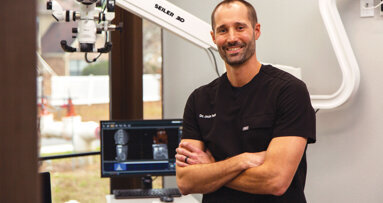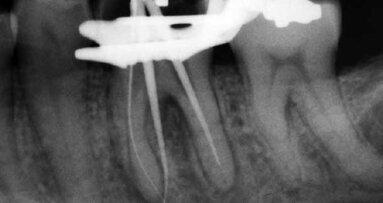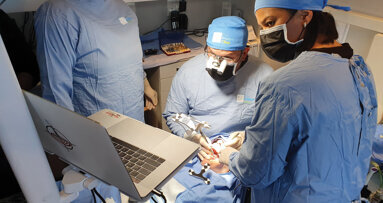When students and residents talk about “doing research,” many are not thinking in the realm of classic research approaches, but rather writing an article on a specific topic or exploring a limited clinical project. Most medical and dental students think about the quantitative approach because it has been used as the method of choice for many years, whereas the social science students are more familiar with qualitative methodologies.
Inquiry into a variety of clinical or theoretical medical and dental topics can employ quantitative, qualitative or both methodologies in the same study. It is time to expand the erudition of research, and it is at the medical and dental student level that such new points of interest must be established.
Until recently, the medical and dental sciences have been more concerned with treating the down stream problems, rather than up the stream etiology of disease. It is essential to focus on treating the systems and not just the symptoms. In order to appreciate that spectrum, it is necessary to acknowledge that research is at the forefront of such knowledge. To facilitate better understanding, diagnosis and treatment of our patients, doctors must appreciate and value research with an open mind and a quest for visualizing medical and dental research.
Basically, research is story telling; it is a methodical and organized inquiry into a theoretical subject or practical understanding of a subject. Research is used to (a) establish or confirm facts, (b) reaffirm results of previous studies, (c) solve new or existing problems, (d) support statements, and/ or (e) develop new theories regarding the hypothetical or practical milieu. A research project may also be an expansion on past work in order to test the validity of instruments, procedures, or experiments, including replication of prior projects or development of new areas.
A classic explanation of the differences between the “theoretical” and “practical” disciplines of medical, dental and scientific research is the: (a) theoretical attempts to understand the causes and nature of health and sickness, while (b) practical struggles to make people healthy. These two areas are related but can also be independent from each other. It is possible to research sickness and health without curing a specific patient, and it is possible to cure a patient without knowing how the cure works.
The primary purpose of “basic” research as opposed to “applied” research is established in the documentation, discovery, development and interpretation of methods, systems or approaches. These research approaches depend on epistemology and vary considerably between the humanities and the sciences.
A primary distinction in scientific research is between a theory and the hypothesis: A theory is a collection of hypotheses that are logically linked together into a coherent explanation of some aspect of reality, which individually or jointly receives some empirical support. Hypotheses are individual and empirically testable conjectures. As a basic review, the three most common research approaches are outlined as follows:
I Quantitative research
II Qualitative research
- Phenomenology
- Ethnography
- Case Study
- Grounded theory
- Historical
III Mixed research
Rationale for research method appropriateness
For a very simple understanding, these three research methodologies (qualitative, quantitative and mixed) have been used to investigate a variety of issues, focusing on different aspects.
A quantitative approach is helpful to develop and employ mathematics, statistics and hypotheses pertaining to a problem. It uses measurements to provide the primary connection and expression of the quantitative relationships. A qualitative research approach is appropriate when gathering in-depth understanding of human and social behavior and the reasons for such behavior. It investigates the how and why rather than the when, what, or where of decision-making, as well as various reactions to, or perceptions of a particular phenomenon.
This approach might assume some commonality to the perceptions of human beings and how they interpret similar experiences seeking to identify, understand and describe these commonalities. The mixed approach has evolved as a pragmatic way of using the strengths of both qualitative and quantitative research methodologies. It is still in its infancy and is expected to become more popular in the next few years.
As a pragmatist and realist, I see the worldview of a research question for allowing the researcher to be open to (a) multiple methods of data collection, such as qualitative and quantitative sources; (b) focus on practical implications of research; and (c) emphasize the importance of conducting research that best addresses the research problem.
As Part 1 left off, the following outline and categories explain the differences between various research approaches: I) Quantitative research; II) ...
As my last two editorials concentrated on research, it would be fitting to present another research matter known as pragmatic research, which is certainly ...
There was a time when people were forced to focus on and improve areas they were not strong in. It was widely accepted to spend enormous amounts of time ...
Web-based dental software delivers a host of advantages over traditional client-server software. Dental practices that utilize the cloud to manage their ...
Dr. Josh Todd is a dual board-certified general dentist and endodontist in Pensacola, Fla. Dental Tribune US sat down with him to get his thoughts on the ...
Nickel titanium rotary shaping files fundamentally changed everything in endodontics; conceptually, procedurally and economically as well. NiTi rotary files...
You’ve heard it on the news: banks just aren’t lending. In addition, more and more practices are discovering that third-party financing ...
As a practicing endodontist over the past 25 five years, you believe you’ve seen whatever can walk in the door case wise. We are taught to look at ...
Less than ten years ago, part of my daily routine as a dental student was changing the fixer and developer solutions in the radiograph processor for the ...
Digital dentistry and the digital workflow have become a critical part of our practice. One of the main reasons for this is the ability for us to better ...
Live webinar
Mon. 12 January 2026
9:00 AM EST (New York)
Prof. Judith Jones D.D.S; M.P.H., Prof. Kakuhiro Fukai D.D.S., Ph.D, Dr. Bathsheba (Bethy) Turton
Live webinar
Wed. 14 January 2026
12:00 PM EST (New York)
Dr. Théo Laplane, Dr. Robert Gottlander DDS
Live webinar
Fri. 16 January 2026
12:00 PM EST (New York)
Live webinar
Mon. 19 January 2026
1:00 PM EST (New York)
Philipp Kopp, Michael Seeber
Live webinar
Thu. 22 January 2026
2:00 PM EST (New York)
Dr. Nicola M. Grande DDS, PhD
Live webinar
Wed. 28 January 2026
8:00 AM EST (New York)
Live webinar
Wed. 28 January 2026
11:00 AM EST (New York)
Prof. Dr. Jan-Frederik Güth



 Austria / Österreich
Austria / Österreich
 Bosnia and Herzegovina / Босна и Херцеговина
Bosnia and Herzegovina / Босна и Херцеговина
 Bulgaria / България
Bulgaria / България
 Croatia / Hrvatska
Croatia / Hrvatska
 Czech Republic & Slovakia / Česká republika & Slovensko
Czech Republic & Slovakia / Česká republika & Slovensko
 France / France
France / France
 Germany / Deutschland
Germany / Deutschland
 Greece / ΕΛΛΑΔΑ
Greece / ΕΛΛΑΔΑ
 Hungary / Hungary
Hungary / Hungary
 Italy / Italia
Italy / Italia
 Netherlands / Nederland
Netherlands / Nederland
 Nordic / Nordic
Nordic / Nordic
 Poland / Polska
Poland / Polska
 Portugal / Portugal
Portugal / Portugal
 Romania & Moldova / România & Moldova
Romania & Moldova / România & Moldova
 Slovenia / Slovenija
Slovenia / Slovenija
 Serbia & Montenegro / Србија и Црна Гора
Serbia & Montenegro / Србија и Црна Гора
 Spain / España
Spain / España
 Switzerland / Schweiz
Switzerland / Schweiz
 Turkey / Türkiye
Turkey / Türkiye
 UK & Ireland / UK & Ireland
UK & Ireland / UK & Ireland
 International / International
International / International
 Brazil / Brasil
Brazil / Brasil
 Canada / Canada
Canada / Canada
 Latin America / Latinoamérica
Latin America / Latinoamérica
 China / 中国
China / 中国
 India / भारत गणराज्य
India / भारत गणराज्य
 Pakistan / Pākistān
Pakistan / Pākistān
 Vietnam / Việt Nam
Vietnam / Việt Nam
 ASEAN / ASEAN
ASEAN / ASEAN
 Israel / מְדִינַת יִשְׂרָאֵל
Israel / מְדִינַת יִשְׂרָאֵל
 Algeria, Morocco & Tunisia / الجزائر والمغرب وتونس
Algeria, Morocco & Tunisia / الجزائر والمغرب وتونس
 Middle East / Middle East
Middle East / Middle East





























































To post a reply please login or register